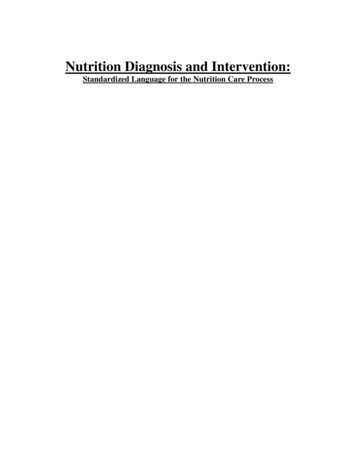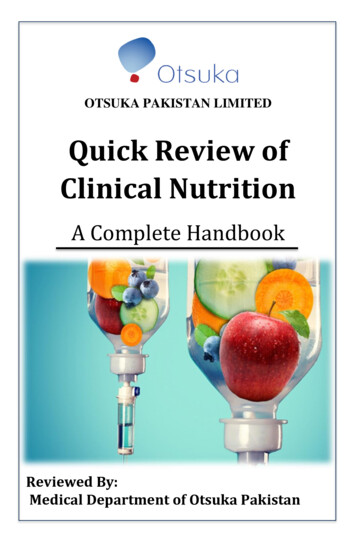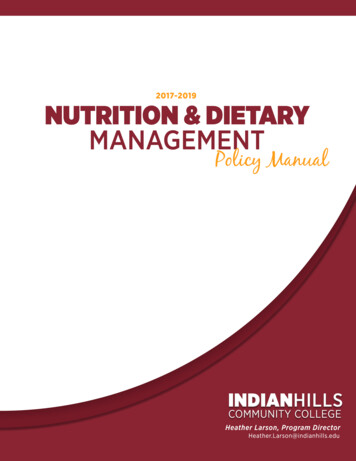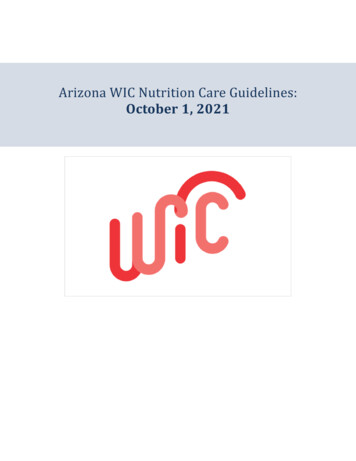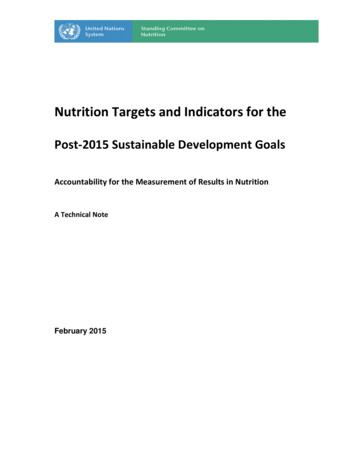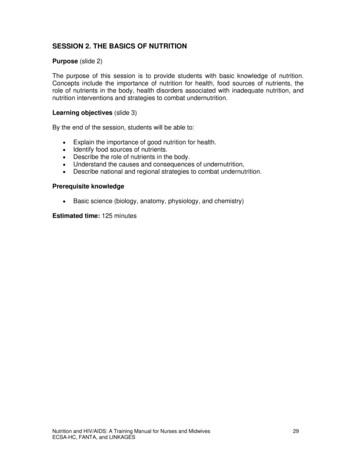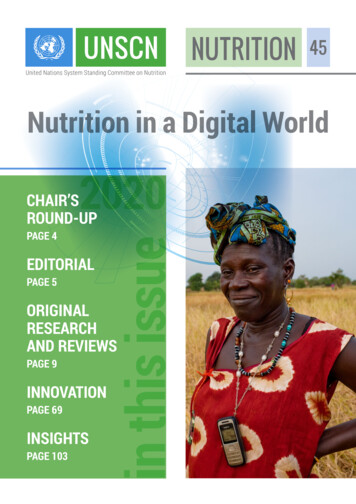
Transcription
UNSCNNUTRITION45United Nations System Standing Committee on NutritionNutrition in a Digital World2020PAGE 4EDITORIALPAGE 5in this issueCHAIR’SROUND-UPORIGINALRESEARCHAND REVIEWSPAGE 9INNOVATIONPAGE 69INSIGHTSPAGE 103
About UNSCN NUTRITIONUNSCN NUTRITION is an annual publication issued by the United Nations System Standing Committee on Nutrition. A transitionaltitle, formerly called SCN News, it can be found under the International Standard Serial Number (ISSN) 1564-3743.It provides information on emerging issues of importance to international nutrition, bringing together contributions fromactors around the globe. Individual authors are accountable and responsible for the content of their papers, the accuracy ofthe references provided and conflict-of-interest declarations. The content of UNSCN NUTRITION should not be consideredan endorsement of the views contained therein and does not necessarily represent the views or official position of theUNSCN Secretariat or its UN Member Agencies. All website links and online information in this publication were accessibleas of June 2020.The UNSCN NUTRITION Editorial Team would like to extend its sincere thanks to the external reviewers who providedsuch valuable feedback on Issue 45.Editorial Team: Denise Costa Coitinho Delmuè, Sabrina Ionata de Oliveira Granheim and Stineke Oenema.Acknowledgements: We would like to thank Poilin Breathnach for compiling the glossary and simplifying the scientificterminology, which we hope will serve as a quick guide to some of the more technical terms used in this report. Wewould also like to gratefully acknowledge Vivica Kraak, Margarida Bica, Kremlin Wickramasinghe, Kathryn Backholer,Bin Liu, Nikola Trendov and Alessandro R Marcon for their contributions to and reviews of the glossary. We wouldalso like to thank Poilin Breathnach for editing the document, Faustina Masini for the design and Alessandra Morafor her support in finalizing the publication.All rights reserved. UNSCN encourages the use and dissemination of content in this product. Reproduction and dissemination thereof for educational orother non-commercial uses are authorized provided that appropriate acknowledgement of UNSCN as the source is given and that UNSCN’s endorsementof users’ views, products or services is not implied in any way.All requests for translation and adaptation rights, and for resale and other commercial use rights should be addressed to the UNSCN secretariat atinfo@unscn.org. To be added to our mailing list, please email info@unscn.org.
Table of contentsAcronyms2Chair’s round-up4Editorial5Original research and reviews9 Digital marketing to young people: Consequences for the health and diets of future generationsUsing mobile-phone technology to change behaviour: Lessons from mNutritionSocial networking for nutrition: Educational intervention in the digital ageSocial-media discussion analysis as a tool for nutrition practitionerseLearning to empower front-line nutrition workers in IndiaDigital solutions for nutrition-sensitive SME transformationDigital marketing of harmful foods to children: A global concern9253341495764Innovation69 697583879296CLICK: The WHO Europe framework to monitor the digital marketing of unhealthy foods to children and adolescentsPLUS School Menus: The future of school menu designFood salvaging to alleviate hunger and food insecurity: The role of mobile technologyDigital technology to promote inclusion and quality nutrition care for children with disabilitiesUsing cutting-edge technology to end malnutritionImproving nutrition and health data to and from remote regionsInsights103 103107116122125132137Harnessing AI to achieve healthy and sustainable food systemsHow digital technology is transforming the food retail landscapeMicrobiome research, nutrition and social media: A messaging muddleDigital solutions to promote nutritious foods: Value chains for biofortified staplesDigital technologies to improve Zimbabwe’s food and nutrition security information systemDigital technology to boost agricultural output, improve the food environment and reduce malnutrition in AfricaDigital accountability for the right to foodTribute141Glossary143
2UNSCN NUTRITION 45: NUTRITION IN A DIGITAL WORLDJuly 2020AcronymsAIArtificial intelligenceATNIAccess to Nutrition IndexAWWAnganwadi worker (India)BCPRBangladesh cerebral palsy registerBMZGerman Federal Ministry for Economic Cooperation and DevelopmentCGFConsumer Goods ForumCHUCommunity health unitsCHVCommunity health volunteersCLICKComprehend the digital ecosystem, Landscape of campaigns, Investigate exposure, Capture on-screen and Knowledge sharingCOPPAChildren’s Online Privacy Protection RuleCOVID-19Novel coronavirus disease 2019 (formerly known as nCov-19)DataDENTData for Decisions to Expand Nutrition TransformationDLTDistributed ledger technologyDHSDemographic and Health SurveysDNNDeep neural networksDWCDDepartment of Women and Child Development (India)FAFHFood away from homeFANRPANFood, Agriculture and Natural Resources Policy Analysis NetworkFaNSFood and Nutrition Security, Enhanced Resilience (project)FAOFood and Agriculture Organization of the United NationsFDAFood and Drug AdministrationFMIFood Marketing InstituteFNCFood and Nutrition Council (Zimbabwe)FNSISFood and nutrition security information systemGAINGlobal Alliance for Improved NutritionGeSIGlobal e-Sustainability InitiativeGIZGesellschaft für Internationale ZusammenarbeitGSMAGSM AssociationHFSSHigh fat, salt and sugarHGSFHome-grown school feedingIBGEBrazilian Institute of Geography and StatisticsICCInternational Chamber of CommerceICTInformation and communications technologyIDSInstitute of Development StudiesIECInformation education and communicationIFADInternational Fund for Agricultural Development
www.unscn.org/unscnnutrition45IFBAInternational Food & Beverage AllianceIFPRIInternational Food Policy Research InstituteILRIInternational Livestock Research InstituteIoTInternet of ThingsITUInternational Telecommunications UnionKFCKentucky Fried ChickenLMICsLow- and middle-income countriesMDDSMinimum Dietary Diversity ScoreMDD-WMinimum Dietary Diversity for WomenMISManagement information systemMUACMid-upper arm circumferenceNCDNon-communicable diseaseNLPNatural language processingNYUNew York UniversityOBCOther Backward Castes (India)OFDOnline food-deliveryOPMOxford Policy ManagementPCDPartnership for Child DevelopmentQR codeQuick Response codeRFIDRadio-frequency identificationRNIRecommended nutrient intakeSADCSouthern African Development CommunitySCScheduled Caste (India)STScheduled Tribe (India)SDStandard deviationSDGSustainable Development GoalsSMESmall and medium-sized enterpriseSNAPSupplemental Nutrition Assistance ProgramSUNScaling Up NutritionUNDESAUnited Nations Department of Economic and Social AffairsUNESCOUnited Nations Educational, Scientific and Cultural OrganizationUNICEFUnited Nations Children’s FundUNSCNUnited Nations System Standing Committee on NutritionUSDAUnited States Department of AgricultureUSDA ERSUnited States Department of Agriculture Economic Research ServiceWASHWater, sanitation and hygieneWCRFWorld Cancer Research FundWFAWorld Federation of AdvertisersWFPWorld Food ProgrammeWHOWorld Health OrganizationWWFWorld Wildlife FundACRONYMS3
4UNSCN NUTRITION 45: NUTRITION IN A DIGITAL WORLDJuly 2020Chair’s round-upAMIR ABDULLAInterim Chair of UNSCN/UN NutritionDeputy Executive Director WFPDear UNSCN Nutrition reader,As Interim Chair of the United Nations System StandingCommittee on Nutrition (UNSCN), I am delighted to present ourflagship publication for 2020, UNSCN Nutrition 45: Nutrition ina Digital World. A wealth of experts, researchers, policymakersand programme implementers have shared their innovations,insights and findings on how digital technologies can be usedto promote sustainable healthy diets and improve nutritionalstatus.When we selected this year’s theme just nine months ago,we had not even heard of COVID-19. We are now in the midstof a pandemic. It dominates our thoughts and actions andis driving fundamental decisions on economic and socialdevelopment.To slow the spread of the coronavirus, restrictions on movementand physical-distancing measures have been put in place aroundthe world. Digital technology has been invaluable in preservingeconomic activity and services and ensuring a functioningfood supply. UNSCN Nutrition 45 has proved very timely inadvancing the debate on the potential effects of innovativedigital technologies on people’s nutrition, both positive andnegative. It has also informed ongoing discussions at the Foodand Agriculture Organizations of the United Nations (FAO) onestablishing an International Platform for Digital Food andAgriculture. The ultimate goal of the International Platform isto realize the potential of digitalization to improve the agrifoodsystem by helping governments and other stakeholders toharness the opportunities these technologies present.As interim Chair of UNSCN, it has been my great privilege to workwith our Members to strengthen UN System-wide coherenceand coordination arrangements on nutrition. I am happy toinform you that these arrangements have moved on to thenext level, with the merger of UNSCN and the UN Network forScaling Up Nutrition (SUN). This combined, robust entity willbe called UN Nutrition. Our flagship publication will continueto address key and emerging nutrition issues under a newname, the UN Nutrition Journal. We are planning to bolsterour editorial board and publishing guidelines.The evolution of UN Nutrition is a tremendous opportunityfor global nutrition. It will enable our UN agencies to workeven more closely and coherently to assist our Members andthe international community in tackling urgent malnutritionchallenges in the second half of the Decade of Action onNutrition, so that we can achieve the Sustainable DevelopmentGoals.We look forward to these new opportunities and will continueto keep you informed. Only together can we overcome theenormous challenges ahead of us and work to improve people’snutrition and well-being, leaving no one behind.Amir AbdullaInterim Chair of UNSCN/UN NutritionDeputy Executive Director WFP
ENISE COSTA COITINHO DELMUÈSABRINA IONATA DE OLIVEIRA GRANHEIMSTINEKE OENEMADigital technologies and the internet are causing radicalglobal change. Digital economies are rapidly replacingtraditional means of production and trade. Digital technologiesare being used throughout the food system (FAO, 2019),influencing the ways in which people interact with it andpotentially redefining their food environments.apps and/or social-media sites. Interestingly, restaurantor takeaway delivery apps did not feature heavily. Rather,recipe apps (15 percent) and recipe websites (36 percent)saw the biggest jumps in usage, confirming findings ofa significant rise in home cooking (75 percent) – with apotentially sizeable, positive impact on nutrition.We chose the theme of UNSCN Nutrition 45: Nutrition in aDigital World long before we had even heard of COVID-19.Our call for contributions closed in February 2020 and, inearly March, COVID-19 was declared a global pandemic.Digitalization has been playing a key role ever since, enablingvital parts of the world economy to continue functioning,allowing us to remain connected and giving us access tonumerous public services, including those directly relatedto the pandemic.Overall, however, the increase in the use of food-relateddigital tools was less significant than we expected. Thesurvey suggested that this might be down to a number offactors. Many viewed food shopping as an opportunityto leave home during quarantine. Others were unable tobook food deliveries if they did not belong to a vulnerableor priority group. Elsewhere, there were considerabledelays in the delivery of online food orders due to highdemand. The survey also showed a desire to support localbusinesses and producers that might not have had thecapacity to ‘go digital’ – a good example of the growingdigital divide. Also, respondents reported high food pricesfor online deliveries. The last two points illustrate somecommon risks associated with digitalization.The disease and the measures taken to curtail its spreadhave caused severe disruption to day-to-day food supplymechanisms and to food environments. In April, the UnitedNations System Standing Committee on Nutrition (UNSCN)conducted an online survey to try to capture how peoplewere dealing with these changes (UNSCN, 2020a). It wascompleted by 2015 people from 118 countries (UNSCN,2020b) and revealed that almost 75 percent of us hadincreased our use of digital tools to cope with recent lifechanges, also when it came to food. Respondents reportedmore frequent use of grocery delivery apps and websites,for example, as well as food delivery through messagingWe had previously featured the topic of digital technologyfor food and nutrition in UNSCN Nutrition 44, whichput forward the idea of a digital food environment that“augments the complexity and intensity of the effects offood environments on the health and nutrition status ofindividuals and populations” (Granheim, 2019: 120). Thearticle suggested that digital technology was affecting
6UNSCN NUTRITION 45: NUTRITION IN A DIGITAL WORLDhealth and nutrition, compounding eating disorders and theprevalence of overweight and obesity and, consequently,fuelling non-communicable diseases (NCDs). Granheim (aguest editor on this edition of UNSCN Nutrition) highlightedthe need to further explore the growing role of digitaltechnology in shaping (un)healthy food systems.UNSCN Nutrition 45 builds on this thesis and examinesthe complexity of the digital world for improved nutritionfrom a range of food-system perspectives – from foodproduction, transformation and distribution to digitalfood marketing and retail; from behavioural change andcapacity-building, including through social media, to thegeneration, processing and use of data; and from theprotection of vulnerable groups to issues of inequalityand human rights.It is essential to bear in mind that digital technology, in andof itself, cannot fix the world’s food and nutrition problems,nor mend its dysfunctional food systems. However, onceimproving nutrition is deemed a priority, digital technologiesare important tools that can help to transform food systemsand assist in the design and delivery of food and nutritionmeasures. Thus, the potential of digital technologies toimprove nutrition is considerable, but so are the risksthat these technologies might entail, as UNSCN Nutrition45 will explore.In addition to our original research and review articles,UNSCN Nutrition 45 includes two new categories: innovationarticles – which focus on tools and new applied technologiesfor improving nutrition – and insights – a collection ofshorter, original articles that give pause for thought onthe nutrition–food–digital technology nexus.DIGITAL TECHNOLOGIES ANDNUTRITIONAs COVID-19 has once again indicated, while the benefitsof digital technologies are many and compelling, they areaccompanied by intrinsic risks and bottlenecks that needto be addressed. The digitalization risks more broadlyinclude increased inequality due to unequal access to digitaltechnologies and digital literacy, cybersecurity breachesand, crucially, ethical and human rights concerns aboutdata privacy and the ownership of health data, biometrics,consumer preference data, behaviour and location tracking,and other personal information.July 2020Another major hurdle is infrastructure. Inadequate physicalinfrastructure, such as weak internet networks andoutdated equipment, and a lack of policy infrastructure,such as regulatory and data-protection frameworks, arewidespread, but have a disproportionate effect on lowand middle-income countries. In addition, while digitalsolutions are evolving, the methods and tools we currentlyhave are not foolproof, for instance, when it comes to biasin data generation and analysis. The limitations of toolssuch as self-learning algorithms need to be considered astechnologies improve.When it comes to nutrition, in particular, knowledge gapsand varying degrees of digital literacy among beneficiaries,nutrition practitioners and policymakers only serve todeepen the digital divide. Political, regulatory and budgetarysupport are often lacking, while inadequate infrastructurecan damp the potential of digital technologies to improvenutrition and leave no one behind.Digital channels are increasingly being used to disseminategeneral, tailored and personalized nutrition messages inan effort to bring about behavioural change. While thesechannels facilitate greater, faster and cheaper audiencereach, widely shared misinformation and disinformationon food and nutrition over the internet is a major concern– and particularly worrying when targeted at children andyoung people. What’s more, digital technology does notreplace the emotional support and reassurance of humaninteraction, which has a pivotal role to play in nutritionalcounselling.Information and data are being produced, shared, used andconsumed at an ever faster pace. More and more people andservices are becoming interconnected around the globe.At the same time, the widening, inequality-fuelled digitaldivide and the impacts of automation on employment havebecome major development challenges. The digital worldpotentially affects not just the underlying and immediatecauses of malnutrition in all its forms, but also its rootcauses and our ability to address them.It is against this backdrop that the potential of digitaltechnologies to improve nutrition must be analysed. Withits rich collection of articles, UNSCN Nutrition 45 aims toenhance our knowledge and further the debate on thepotential benefits and adverse impacts of innovative digitaltechnologies in helping to achieve sustainable healthydiets and progressively realize the right to adequate food.
www.unscn.org/unscnnutrition45Most of the articles we present in UNSCN Nutrition 45consider this duality. We believe this anthology helps toidentify some of the areas where risks appear high andregulation is needed, as well as some where positiveimpacts can be expected and should be encouraged.Thus, we hope, it can play a role in building a commonunderstanding that can drive joint action and initiativesto improve people’s nutrition.THE WAY FORWARDDigital processes and technologies are reshaping almostevery industry and aspect of human activity. Their potentialto accelerate food-system transformation for sustainablehealthy diets has not yet been sufficiently investigated, letalone understood. The COVID-19 pandemic has highlightedthat we need to invest in a robust digital infrastructure andthe widespread digitalization of services, with a particularfocus on disadvantaged areas. Digitalization is not onlyabout infrastructure, however. It is also about how we usethese technologies and how they change our culture. It isabout digital skills. Additional information-gathering and-sharing and further exploratory research are urgentlyneeded to tap into this potential while minimizing theassociated risks.ReferencesFAO. 2019. Digital Technologies in Agriculture and Rural Areas: Status Report.Rome. (also available at http://www.fao.org/3/ca4985en/ca4985en.pdf).FAO. 2020a. Realizing the potential of digitalization to improve the agri-foodsystem proposing a new international digital council for food and agriculture:a concept note. JM 2020.1/3 – Information Note 1. Rome. (also available athttp://www.fao.org/3/nd091en/nd091en.pdf).FAO. 2020b. The GFFA 2020’s call upon FAO’s Governing Bodies“to support a process” for “the establishment of an International Digital Councilfor Food and Agriculture”. CCLM 110/4 Rev.1. Rome. (also available at http://www.fao.org/3/nc376en/nc376en.pdf).Global Panel on Agriculture and Food Systems for Nutrition (GlobalPanel). 2016. Food systems and diets: Facing the challenges of the 21stcentury. London. (also available at ForesightReport.pdf).Granheim, S.I. 2019. The digital food environment. In UNSCN Nutrition 44 –Food environments: Where people meet the food system: 115–121. Rome, UnitedNations System Standing Committee on Nutrition. (also available at tion44-WEB-21aug.pdf).EDITORIAL7The Food and Agriculture Organization of the United Nations(FAO) is currently in talks to establish the InternationalPlatform on Digital Food and Agriculture (FAO, 2020a,2020b) to advise governments and other stakeholders, fuelan exchange of ideas and experiences, foster innovation andhelp harness the opportunities presented by digitalizationin food and agriculture.Capitalizing on digital technologies to promote sustainable,healthy diets and improved nutrition needs to be at the coreof this and all other debates on digitalization for health,for food and agriculture, and for achieving the SustainableDevelopment Goals, to ensure that no one is left behind.We hope you enjoy reading UNSCN Nutrition 45 and welcomeyour feedback.The Editorial TeamKraak, V.I., Rincón-Gallardo Patiño, S. & Sacks, G. 2019. Accountabilityevaluation for the International Food & Beverage Alliance’s Global Policy onMarketing Communications to Children to reduce obesity: a narrative reviewto inform policy. Obesity Reviews, 20(S2): 90–106. (also available at br.12859).UNSCN. 2020a. UNSCN COVID-19 Survey. Rome. (also available at bzx 6018486058396910573).UNSCN. 2020b. COVID-19 pandemic: The evolving impact on how people meetthe food system. Rome. (also available at news 2065).WHO. 2020. Coronavirus disease 2019 (COVID-19): Situation Report – 86.Geneva, Switzerland. (also available at f?sfvrsn c615ea20 6).
8UNSCN NUTRITION 45: NUTRITION IN A DIGITAL WORLDIFAD/ BERNARD KALUJuly 2020
www.unscn.org/unscnnutrition45ORIGINAL RESEARCH AND REVIEWS9Original researchand reviewsDigital marketing to young people: Consequences for thehealth and diets of future generationsVIVICA I. KRAAK, MI ZHOU and SOFIA RINCÓN-GALLARDO PATIÑOVirginia Polytechnic Institute and State University (Virginia Tech), Blacksburg, VAContact the authors at: vivica51@vt.eduAuthors’ statement: The authors declare having no conflicts of interest in the five years prior to this submission.We thank Lori Dorfman at the Berkeley Media Studies Group for comments on an earlier version of this paper.ABSTRACTDigital marketing is widely used to promote highlyprocessed food and beverage products with excessiveenergy and high in fat, sugars and salt (HFSS) to youngpeople, negatively impacting their diet and health. In thispaper, we describe the global trends in digital marketingused to promote unhealthy HFSS products to children,adolescents and young adults aged 7 to 24 years. We reviewthe digital privacy policies of 18 major transnational firms— six technology and 12 international food and beveragecompanies — to promote food and beverage products,brands and healthy and sustainable lifestyles to youngpeople. Our analysis shows that four of the six technologyfirms have privacy-protection policies for children under13 years, but that no firm has a digital marketing policy torestrict the targeting of HFSS food and beverage productsto young people. Only one of the 12 food and beveragecompanies studied has publicly pledged not to use digitalmarketing to promote HFSS food and beverage productsto adolescents (aged 13–18). Governments must developcomprehensive privacy-protection laws that restrict firmsfrom using digital marketing to promote HFSS products toyoung people and only allow products that meet healthynutrient-profile criteria. Global and national actors shouldencourage these 18 firms to adopt best practices to usedigital marketing to support healthy and sustainable diets,lifestyles and food systems for future generations.INTRODUCTIONOur globalized food system cannot sustainably promotehealthy people and a healthy planet (Swinburn et al., 2019).Companies are using digital technologies to perpetuateunsustainable consumer behaviours that contribute toobesity (Montgomery et al., 2018) and climate change(Swinburn et al., 2019), despite hopes that these technologieswould foster social and emotional development, encouragehealthy and sustainable choices and mobilize adolescentsand young adults to transform their future (Burke-Garciaand Scally, 2014; Patton et al., 2016; UNICEF, 2017).Global food-system actors have made limited progresson restricting the widespread marketing to young people
10UNSCN NUTRITION 45: NUTRITION IN A DIGITAL WORLDof processed, energy-dense and nutrient-poor food andbeverage products that are high in fat, sugar and salt(HFSS) and which are linked to poor diet quality, increasedobesity, diet-related non-communicable diseases (NCDs)and climate change (Kraak et al., 2016; Kraak et al., 2019;Swinburn et al., 2019). The World Obesity Federation (2019)estimates that 254 million children between the ages of5 and 19 in 191 countries will be obese by 2030. China(61.9 million), India (27.5 million) and the United Statesof America (16.9 million) will have the highest obesityburdens (World Obesity Federation, 2019). Poor diet is aleading risk factor in NCD mortality, associated with 11million deaths and 255 million disability-adjusted life yearsglobally in 2017 (Afshin et al., 2019).Numerous United Nations and other expert reports haveurged state and non-state actors to take comprehensiveaction to tackle malnutrition in all its forms and createhealthy and sustainable food systems that are resilient toclimate change (Branca et al., 2020; Hawkes et al., 2020;Swinburn et al., 2019; UNICEF and GAIN, 2018; Willett etal., 2019). These reports have not investigated how digitalmarketing could be used to achieve these goals, however.If we are to align the great intergenerational foodtransformation of the United Nations Decade of Actionon Nutrition (2016-2025) with the 2030 SustainableDevelopment Goals (Swinburn, 2019), young people musthave supportive built and virtual environments and thecapacity to mobilize resources to advocate for and adopthealthy and sustainable consumption patterns that staywithin planetary boundaries (Swinburn et al., 2019).This paper builds on a UNSCN Nutrition 44 paper (Granheim,2019) addressing the under-explored issue of how transnationalfirms use digital marketing and media technologies toreach young people. We use the term “digital marketing”to refer to any promotional activity delivered through adigital or social-media platform, aimed at individuals,groups and/or populations.The paper has six objectives. First, we examine the globaltrends in digital marketing targeted at young people —children(under 12 years), adolescents (12–18 years) and youngadults (19–25 years). Second, we explore the child- andadolescent-focused privacy and marketing policies of sixtransnational technology firms that own popular social-mediaplatforms. Third, we review the policies of 12 InternationalFood & Beverage Alliance (IFBA) firms on the marketingJuly 2020of food and non-alcoholic beverage products, brands andhealthy and sustainable lifestyles to young people. Fourth,we examine evidence from 16 studies (2014–2020) onhow 18 transnational firms have used digital marketingand social-media platforms to engage young people withfood and beverage products and brands. Fifth, we comparethese policies with best-practice recommendations toreduce children’s exposure to digital marketing. Sixth, wesuggest policies and actions for global and national actors,including United Nations agencies and Member States,technology and food and beverage firms, and civil-societyorganizations (CSOs), to ensure that digital marketing andmedia are used to foster healthy and sustainable diets,lifestyles and food systems for future generations.GLOBAL TRENDS IN DIGITALMARKETING TARGETED ATYOUNG PEOPLEThe 2019 Global Digital Report estimates that nearlyhalf (3.5 billion) of the world’s population currently usessocial-media platforms (We are Social, 2019). Children andadolescents are rapid adopters and frequent consumersof digital marketing communications and social media(Patterson et al., 2016). Children and adolescents of thecurrent generation are digital natives, raised in digitalmedia-immersed environments, exposed to computers,videogames and social-media applications (apps) from anearly age, which influences how they think and processinformation (Dingli and Seychell, 2015).The United Nations Children’s Fund (UNICEF) (2018a)describes digital technologies as “revolutionizing marketingstrategies to broaden their influence” and reach peoplein more than 200 countries (Figure 1). The State of theWorld’s Children 2017 report focused on young peopleaged 15 to 24 years in the digital world (UNICEF, 2017). At71 percent, this is the most internet-connected age group,compared with just under half (48 percent) of the totalworld population. Yet, about 29 percent of young people(346 million youths), notably in Africa, are disadvantagedby the digital divide, with limited access to the internetor online digital technologies, unlike their counterparts inthe more affluent countries of Europe, the Americas andOceania (UNICEF, 2017).
www.unscn.org/unscnnutrition45Figure 1.HOW DIGITAL MEDIA ARE USED TO TARGET AND INFLUENCEYOUNG PEOPLEORIGINAL RESEARCH AND REVIEWS11platforms and social-networking websites that influencepeer interactions, diet and health outcomes (Boyland etal., 2020; Kelly et al., 2015; Montgomery et al., 2012).Studies in European countries have shown that chi
NYU New York University OBC Other Backward Castes (India) OFD Online food-delivery OPM Oxford Policy Management PCD Partnership for Child Development . UNSCN United Nations System Standing Committee on Nutrition USDA United States Department of Agriculture USDA ERS United States Department of Agriculture Economic Research Service WASH Water, .


